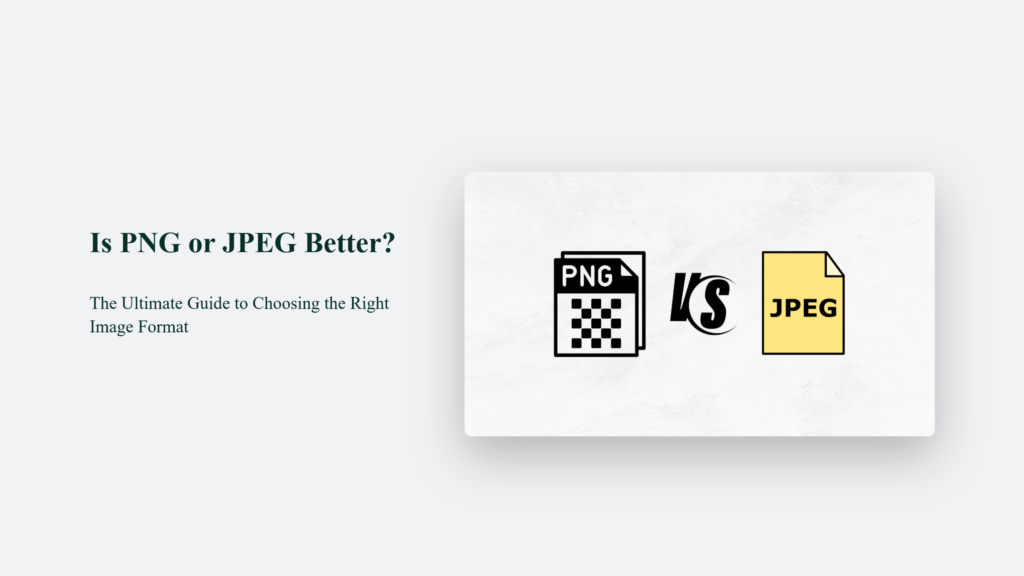Two formats often come up in conversation when diving into digital images: PNG and JPEG. Each format has unique strengths and uses, making choosing between them crucial for your image needs. But worry not! We’ll simplify this choice, even if you’re only as familiar with tech as a 5th grader. So, is PNG or JPEG better? Let’s find out.

What Are PNG and JPEG?
PNG (Portable Network Graphics) files shine because they compress images without losing quality. Think of it as packing a suitcase without leaving your favourite toys behind. They’re perfect for detailed graphics and logos with that cool see-through background, and you can use them whenever you want your images to look sharp and clear, no matter how many times you open them.
On the other hand, JPEG (Joint Photographic Experts Group) files are the globetrotters of the image world. They’re designed to make photos smaller so you can share and load them easily on the web. Imagine being able to fit all your holiday photos into a tiny suitcase. JPEGs make this possible, but sometimes at the expense of leaving a few details behind.
JPEG vs. PNG: When to Use Which?
- Team JPEG: Best suited for your holiday snaps or any photo with smooth colour transitions. JPEGs are your go-to when space is tight, and you’re okay with sacrificing a bit of quality for a more manageable file size.
- Team PNG: The heroes of clarity and details. Use PNGs for your website’s logos, icons, and any graphic where crisp lines or text matter. They’re also the only choice when you need that fancy transparent background.
Is PNG or JPEG Better?
Compression
- JPEGs utilize a “lossy” compression technique. It means that when the file size is reduced, some data from the original image is permanently lost. It’s a trade-off that makes JPEGs smaller and faster to load, but at the potential cost of image quality, especially after repeated editing.
- PNGs, on the other hand, employ “lossless” compression. This method retains all the original data of the image, ensuring no quality is lost regardless of how often the file is edited or saved. PNGs are ideal for images requiring frequent adjustments or users prioritizing quality over file size.
File Size
- The compression methods directly impact file size. JPEG files are generally smaller and more efficient to share and upload, making them well-suited for use on the web where loading speed is a concern.
- Due to their lossless compression, PNG files tend to be larger. While this means they maintain higher quality, it also results in bigger files that may take up more storage space and take longer to load on web pages.
Transparency
- A distinctive feature of PNGs is their support for transparency. It allows for creating images with clear, transparent backgrounds or elements within the image. It’s a crucial feature for web design, allowing logos and graphics to seamlessly integrate with various backgrounds.
- JPEGs do not support transparency. This limitation means that any supposed transparent background will be filled with a solid colour, usually white, which can restrict their use in certain design contexts.
Usage
- Each format plays to its strengths. JPEGs are best utilized for photographs and images where a broad colour range and compact file size are prioritized over absolute clarity. Their efficient compression makes them ideal for storing and sharing vast quantities of photos where subtle details lost are not a concern .
- PNGs are preferred for digital graphics, such as web design elements, icons, and any imagery where sharpness, clarity, and detail are paramount. Their ability to maintain quality and support transparency makes them suitable for professional printing, web graphics, and any application where precision is key.
Examples:
- JPEG: Great for Facebook profile pictures or any place where you want good-quality photos without using up all your storage.
- PNG: Perfect for a company logo that you want to look sharp against any background on your website.
The Bottom Line:
Choosing between PNG and JPEG doesn’t have to be a headache. Consider what’s more important for your specific situation: file size or image quality. Whether you’re sharing photos from your latest adventure or designing a logo for your startup, knowing the strengths of each format helps you make the right choice.
Frequently Asked Questions:
Can I convert PNG to JPEG and vice versa?
Yes, but converting JPEG to PNG might not bring back lost details, and converting PNG to JPEG might add unnecessary file size without quality benefits.
Which is better for web use?
It depends on your needs. JPEGs load faster, making them suitable for photos on web pages. PNGs are better for logos and graphics where detail and transparency matter.
Are PNGs always larger than JPEGs?
Generally, yes, because PNGs keep all the original data. But for images like logos, the difference might not be significant.




